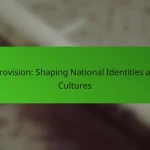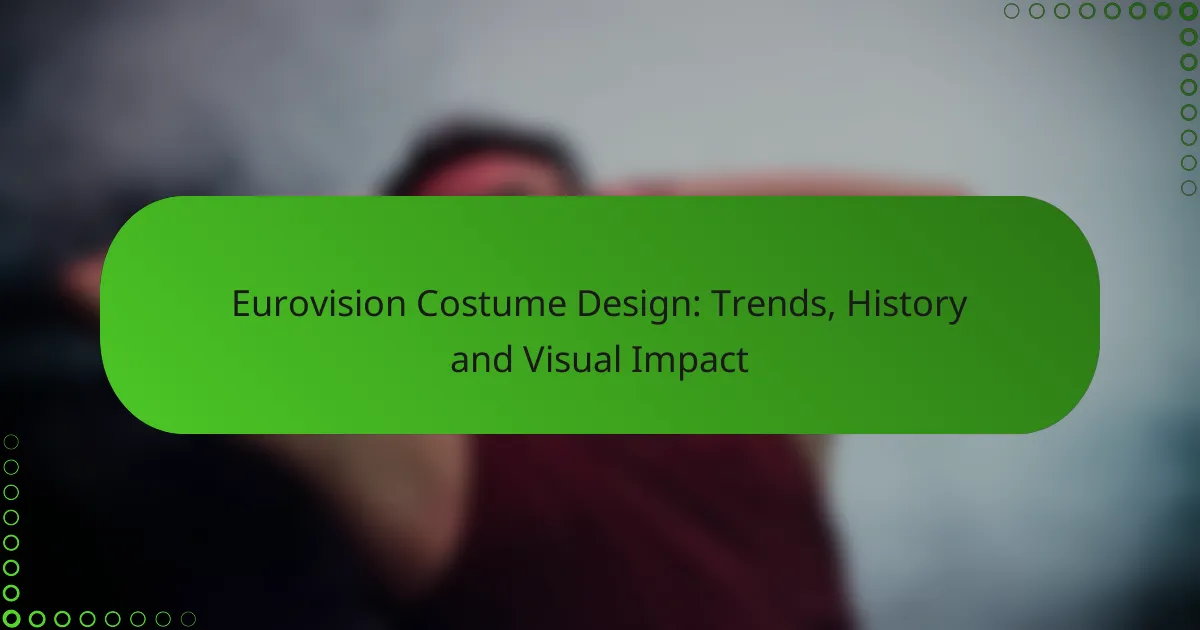Eurovision costume design has evolved dramatically since the contest began, mirroring cultural shifts and artistic trends over the decades. Today, designers embrace bold aesthetics, innovative materials, and inclusive styles that celebrate diverse identities, creating a vibrant visual impact that enhances performances and resonates with audiences.

What are the latest trends in Eurovision costume design?
The latest trends in Eurovision costume design emphasize bold aesthetics, technological integration, and cultural narratives. Designers are increasingly focusing on vibrant colors, innovative materials, and inclusive styles that reflect diverse identities.
Bold colors and patterns
Bold colors and striking patterns are central to Eurovision costumes, creating a visual spectacle that captures audience attention. Bright hues like electric blue, neon pink, and vivid green are commonly used to convey energy and excitement.
Patterns often include geometric shapes, florals, and abstract designs, allowing performers to stand out on stage. Designers frequently experiment with contrasting colors to enhance visual impact and create memorable looks.
Integration of technology
Technology plays a significant role in modern Eurovision costume design, enhancing both functionality and aesthetics. Costumes may incorporate LED lights, interactive elements, or even augmented reality features that engage viewers and elevate performances.
For example, costumes can change color or display patterns in sync with music, adding a dynamic layer to the performance. This integration not only captivates the audience but also allows for creative storytelling through visual effects.
Cultural representation
Cultural representation is increasingly important in Eurovision costumes, reflecting the diverse backgrounds of participants. Designers often draw inspiration from traditional attire, folklore, and regional symbols to create costumes that honor cultural heritage.
This trend fosters inclusivity and allows artists to share their stories through fashion. By incorporating elements from their own cultures, performers can connect with audiences on a deeper level and celebrate their identities.
Eco-friendly materials
Eco-friendly materials are gaining traction in Eurovision costume design as sustainability becomes a priority in the fashion industry. Designers are exploring fabrics made from recycled materials, organic cotton, and biodegradable options to reduce environmental impact.
Using sustainable materials not only aligns with global efforts to combat climate change but also appeals to environmentally conscious audiences. This trend encourages a shift towards responsible fashion choices within the entertainment sector.
Gender fluidity in designs
Gender fluidity is a prominent trend in Eurovision costume design, breaking traditional gender norms and embracing a more inclusive approach. Designers are creating outfits that blend masculine and feminine elements, allowing performers to express their identities freely.
This shift encourages creativity and individuality, with costumes featuring a mix of tailored suits, flowing dresses, and androgynous styles. By challenging conventional gender representations, Eurovision costumes reflect a broader cultural movement towards acceptance and diversity.
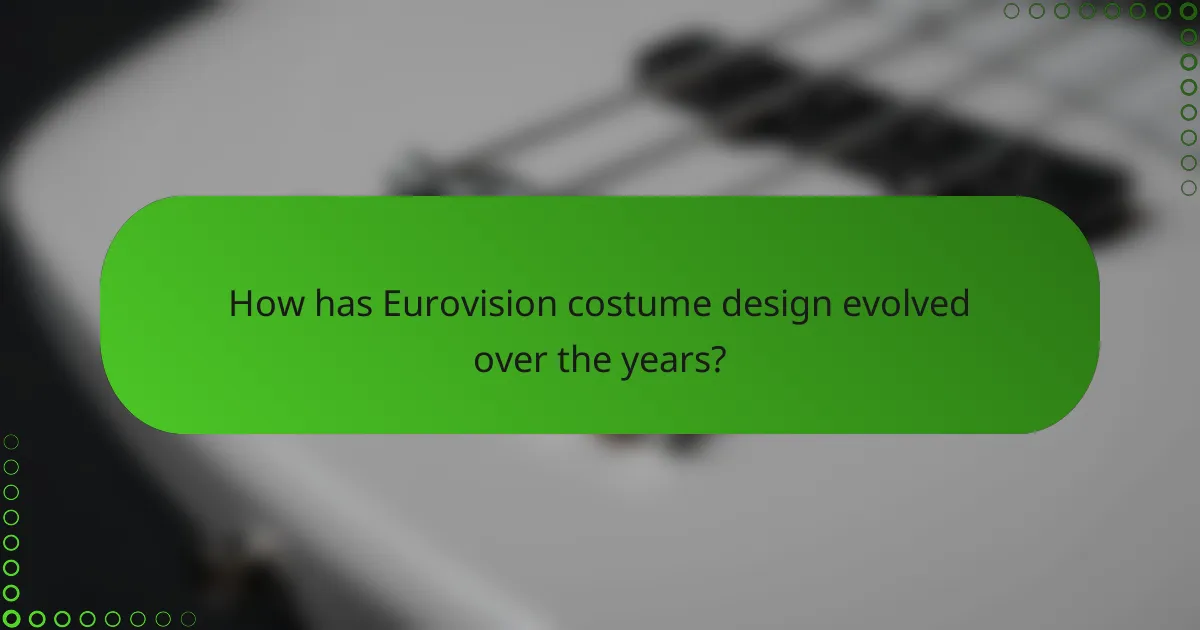
How has Eurovision costume design evolved over the years?
Eurovision costume design has transformed significantly since the contest’s inception in the mid-20th century, reflecting broader cultural shifts and artistic trends. From simple outfits to extravagant ensembles, the evolution showcases a blend of national identity and global influences.
Historical influences from the 1950s
The 1950s marked the beginning of Eurovision, where costumes were often modest and aligned with the traditional styles of participating countries. Early performances featured outfits that emphasized national pride, with many artists donning folk-inspired clothing that resonated with their cultural heritage.
As the years progressed, the influence of fashion trends began to emerge, with the 1960s introducing more vibrant colors and bold designs. This shift reflected the growing popularity of pop music and the desire to stand out on stage.
Impact of pop culture
Pop culture has played a crucial role in shaping Eurovision costume design, particularly from the 1970s onward. The rise of glam rock and disco brought flamboyant styles, encouraging performers to embrace more daring and theatrical outfits that captivated audiences.
Today, designers often draw inspiration from current fashion trends, celebrity styles, and even social movements, resulting in costumes that not only entertain but also convey powerful messages. This connection to pop culture ensures that Eurovision remains relevant and engaging for diverse audiences.
Notable designers through the decades
Several designers have left a significant mark on Eurovision costume design, influencing the visual impact of performances. For instance, the iconic Jean-Paul Gaultier created memorable outfits for artists like Madonna, blending high fashion with performance art.
In recent years, designers such as the Swedish duo, Thelma & Louise, have gained recognition for their innovative and bold designs, pushing the boundaries of traditional costume aesthetics. Their work exemplifies how contemporary designers continue to evolve the visual narrative of Eurovision.
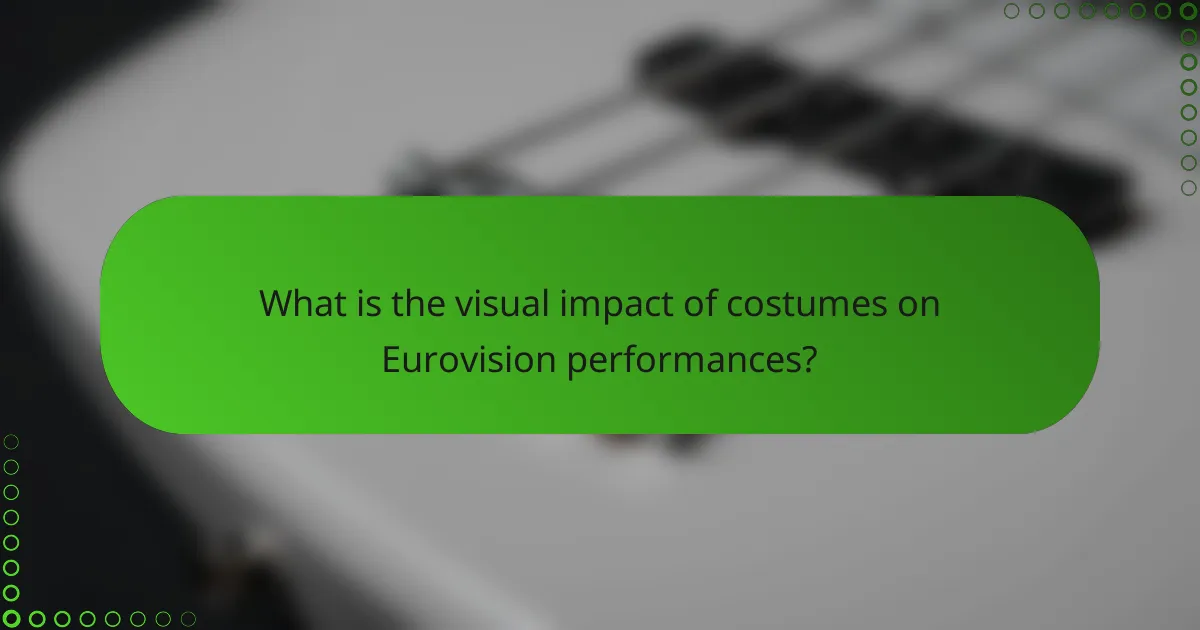
What is the visual impact of costumes on Eurovision performances?
The visual impact of costumes on Eurovision performances is significant, as they enhance the overall presentation and help convey the artist’s message. Costumes can create a memorable aesthetic that resonates with audiences, influencing their emotional connection to the performance.
Enhancement of stage presence
Costumes play a crucial role in enhancing an artist’s stage presence during Eurovision performances. Bold colors, unique designs, and eye-catching accessories can draw attention and create a striking visual narrative. For example, a performer in a shimmering gown or an elaborate outfit can dominate the stage, making it easier for the audience to focus on them.
Additionally, costumes can reflect the theme of the song, reinforcing the message and mood. A cohesive look that aligns with the performance can elevate the overall impact, making it more engaging for viewers.
Influence on audience engagement
Costumes significantly influence audience engagement by creating a visual spectacle that captivates viewers. When performers wear innovative or culturally significant outfits, it can spark curiosity and conversation among fans. This engagement often extends to social media, where unique costumes can go viral, further amplifying the performance’s reach.
Moreover, costumes can evoke emotional responses, making the performance more relatable. For instance, traditional attire can connect with cultural heritage, while modern, avant-garde designs can appeal to contemporary tastes, drawing in diverse audience segments.
Memorable fashion moments
Eurovision is known for its memorable fashion moments that often become iconic. Outfits that stand out, such as those featuring extravagant embellishments or unconventional materials, can leave a lasting impression on viewers. For example, costumes that incorporate national symbols or innovative designs often become talking points long after the event.
These fashion statements can influence future trends in the music and fashion industries, as artists and designers draw inspiration from the bold choices made on the Eurovision stage. Such moments not only highlight individual creativity but also contribute to the evolving narrative of performance art in popular culture.
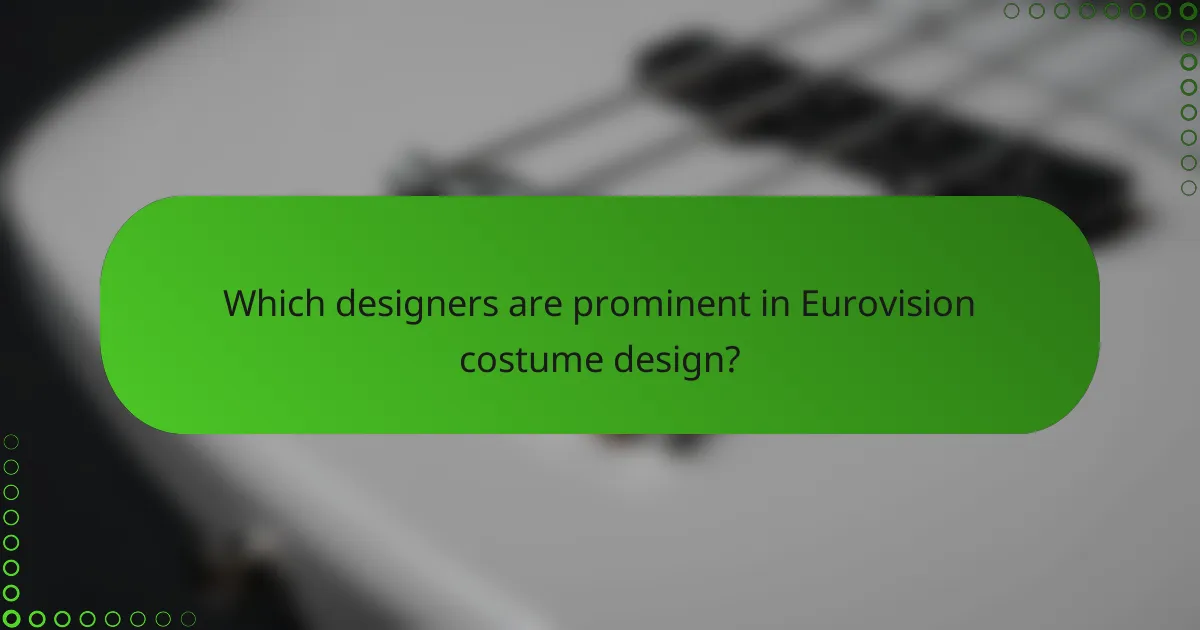
Which designers are prominent in Eurovision costume design?
Several designers have made significant contributions to Eurovision costume design, shaping the visual identity of the event. Notable figures include Jean Paul Gaultier and Alexander McQueen, alongside a growing number of local designers who are gaining recognition for their unique styles.
Jean Paul Gaultier’s contributions
Jean Paul Gaultier is renowned for his avant-garde and theatrical designs, which have left a lasting mark on Eurovision. His bold use of materials and unconventional silhouettes often push the boundaries of traditional costume design, making performances unforgettable.
One of Gaultier’s most iconic pieces was the corset worn by Madonna during her performance, which exemplified his ability to blend fashion with performance art. His work often incorporates elements of cultural references, adding depth to the visual storytelling of the performances.
Alexander McQueen’s influence
Alexander McQueen’s influence on Eurovision costume design is characterized by his dramatic and often dark aesthetic. His designs frequently challenge norms and provoke thought, which aligns well with the event’s spirit of creativity and expression.
McQueen’s theatricality is evident in costumes that feature intricate detailing and bold statements. His legacy continues to inspire designers who aim to create costumes that not only complement the music but also convey powerful narratives.
Local designers making an impact
Local designers across Europe are increasingly making their mark on Eurovision, bringing regional styles and cultural elements to the forefront. These designers often draw inspiration from their heritage, creating costumes that resonate with both local and international audiences.
For example, designers from countries like Bulgaria and Italy incorporate traditional motifs and fabrics into modern designs, creating a fusion that celebrates their cultural identity. This trend not only enhances the visual impact of performances but also fosters a sense of pride and connection among viewers.
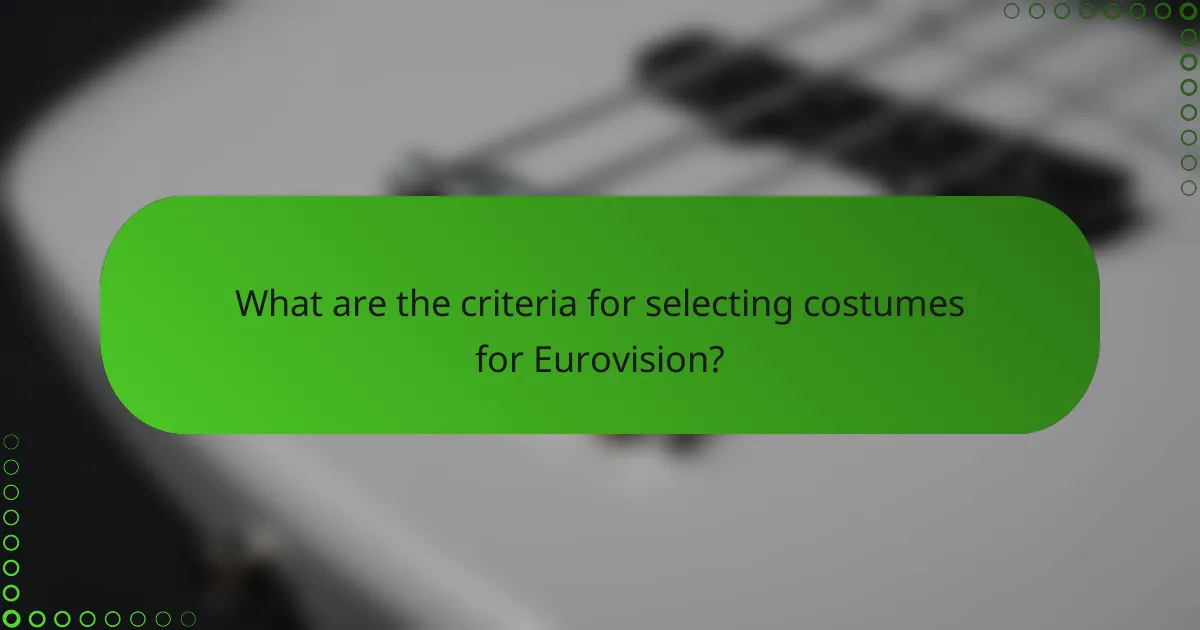
What are the criteria for selecting costumes for Eurovision?
Costume selection for Eurovision is primarily based on alignment with the song’s themes, visual impact, and cultural representation. Designers must consider how costumes enhance the performance and resonate with the audience while adhering to the event’s standards.
Alignment with song themes
Costumes must reflect the themes and emotions conveyed in the song. For instance, a ballad may call for elegant, flowing garments, while an upbeat pop song might inspire vibrant, energetic outfits. This alignment helps create a cohesive performance that enhances the overall message.
Designers often analyze lyrics and musical elements to inform their choices. For example, if a song references nature, costumes might incorporate floral patterns or earthy tones. This thematic connection not only strengthens the performance but also engages the audience on a deeper level.
Visual impact
Visual impact is crucial in Eurovision, where first impressions matter. Costumes should be eye-catching and memorable, often utilizing bold colors, unique silhouettes, and striking accessories. This helps performers stand out among a diverse lineup of acts.
Effective use of materials can enhance visual appeal. Shiny fabrics, sequins, and LED elements are popular choices that draw attention under stage lights. Designers should balance these elements to ensure costumes are not only stunning but also comfortable for performers to move in.
Cultural representation
Cultural representation plays a significant role in costume design for Eurovision. Costumes often reflect the artist’s heritage and national identity, showcasing traditional elements or modern interpretations of cultural attire. This adds authenticity and depth to the performance.
Designers should research cultural symbols and styles to ensure respectful representation. For example, incorporating traditional motifs or colors can resonate with both local and international audiences. However, it’s essential to avoid stereotypes and ensure that the representation is meaningful and appropriate.



